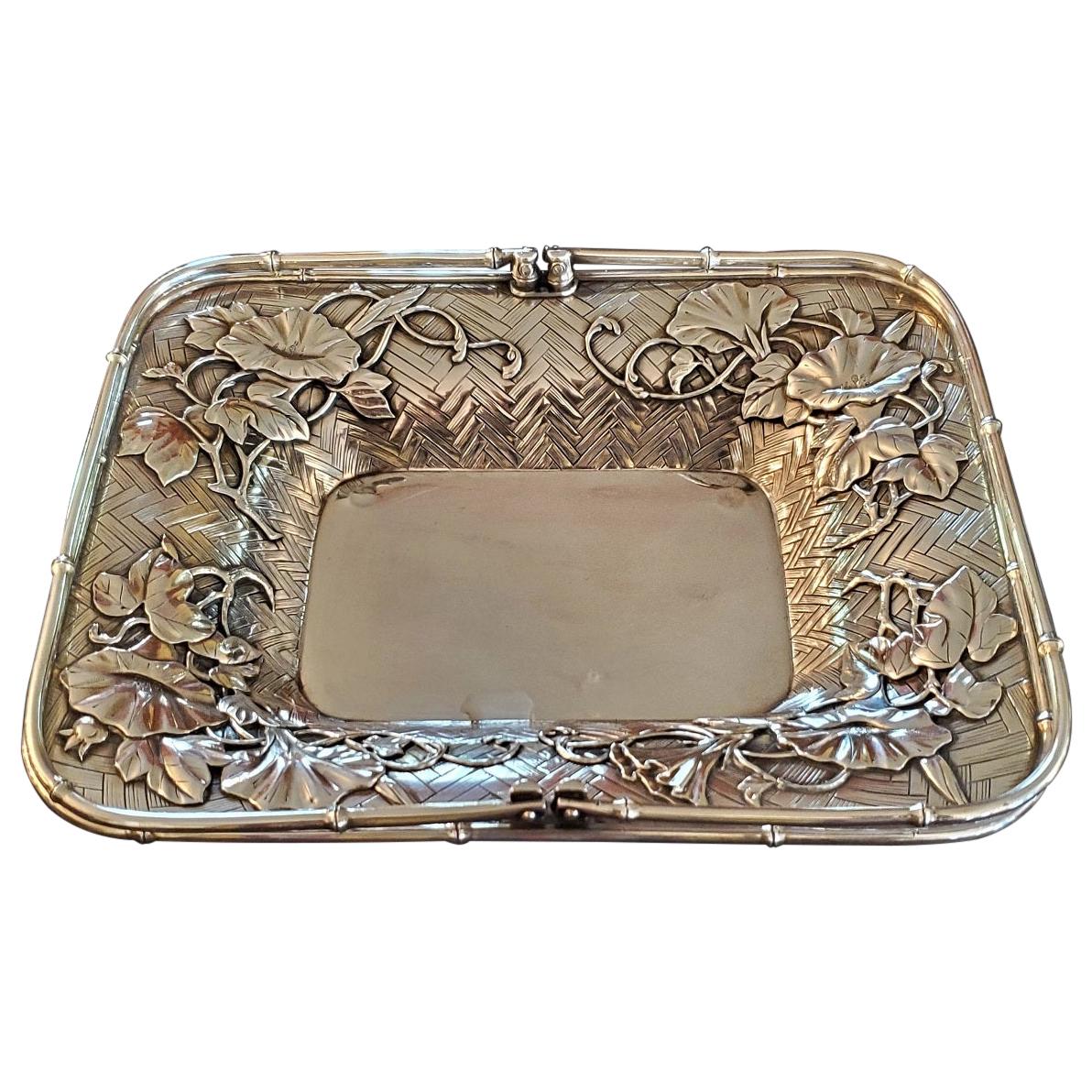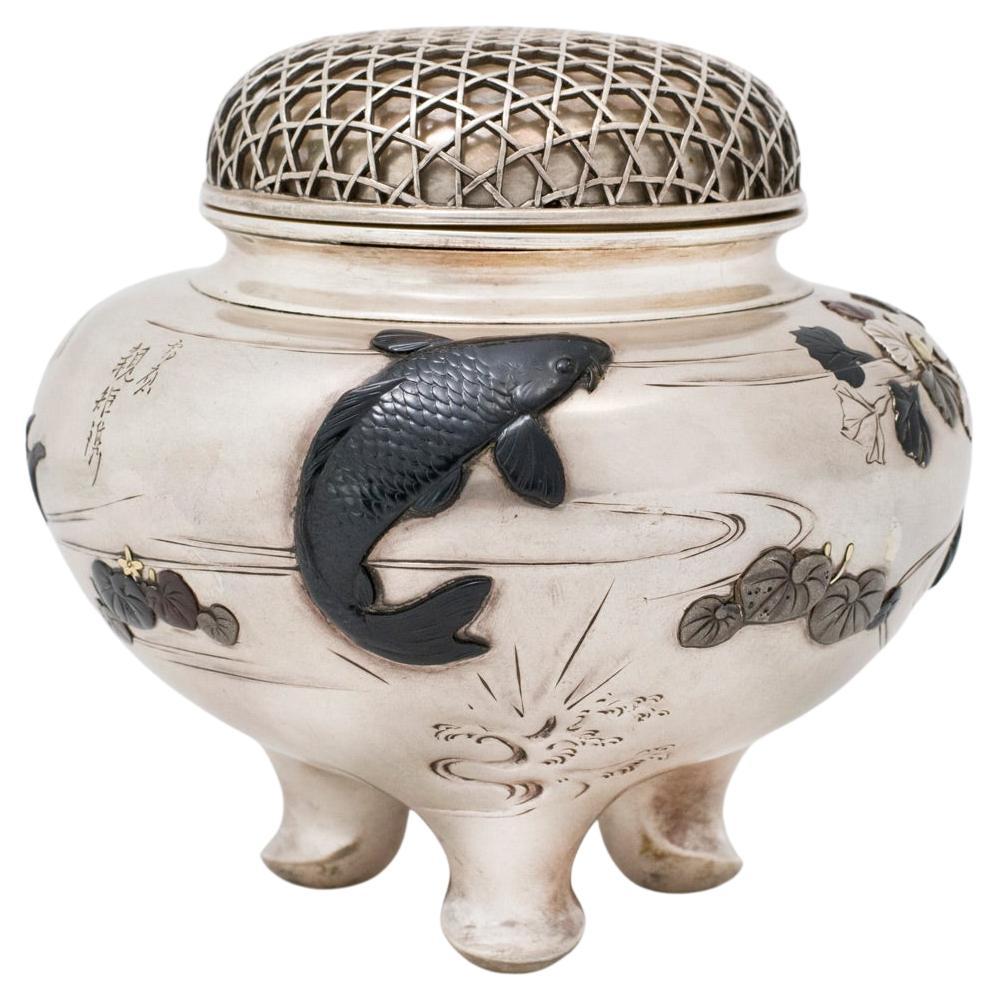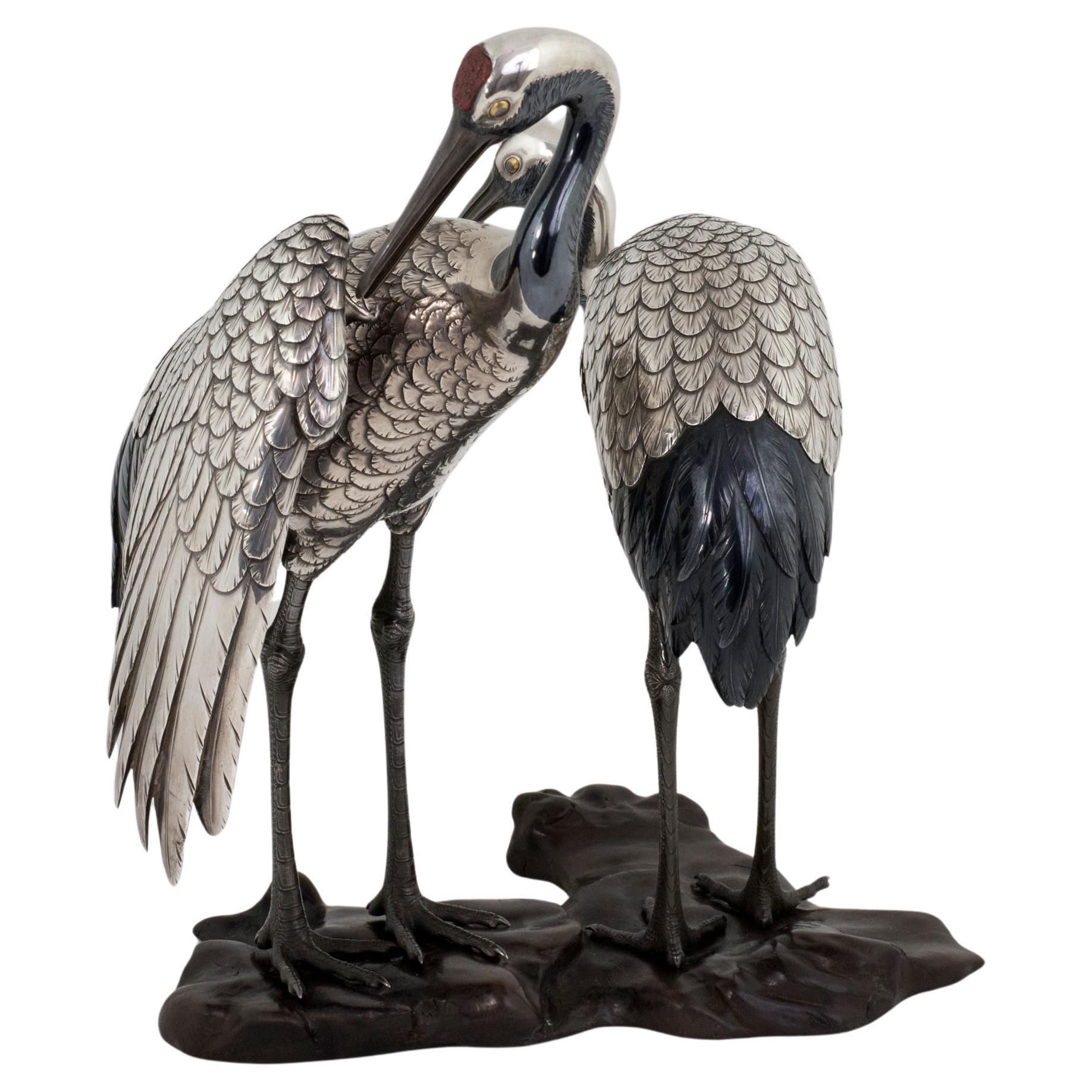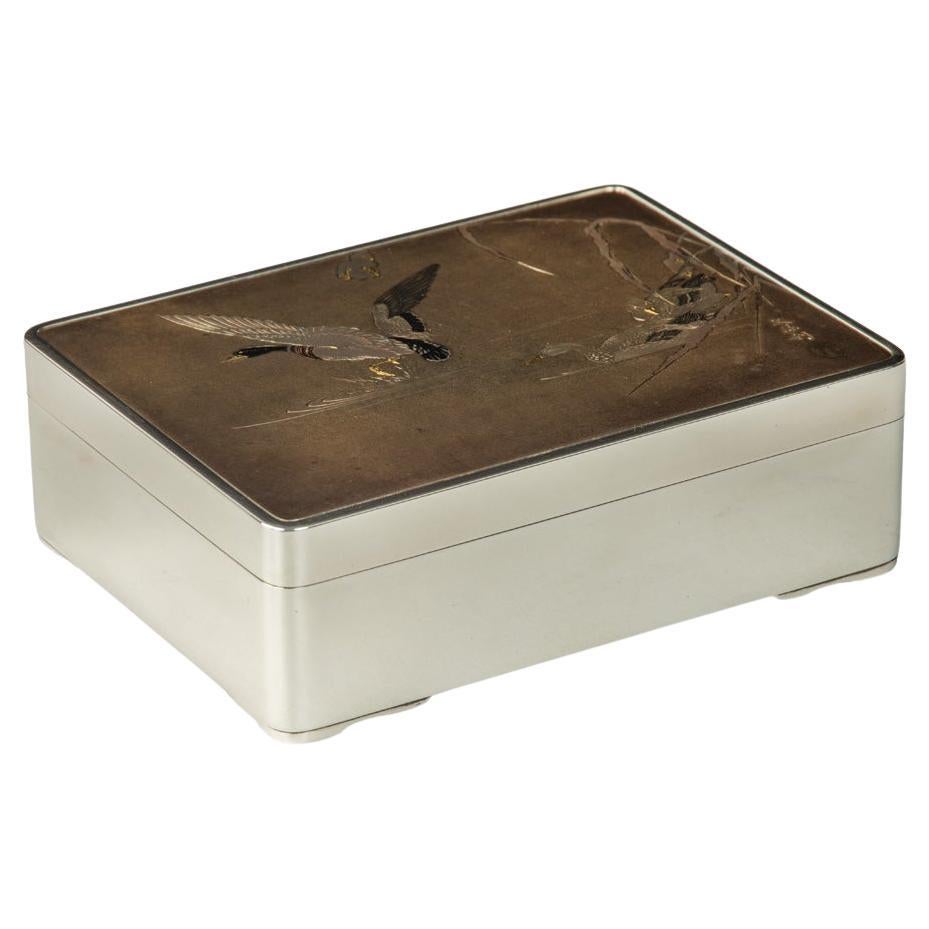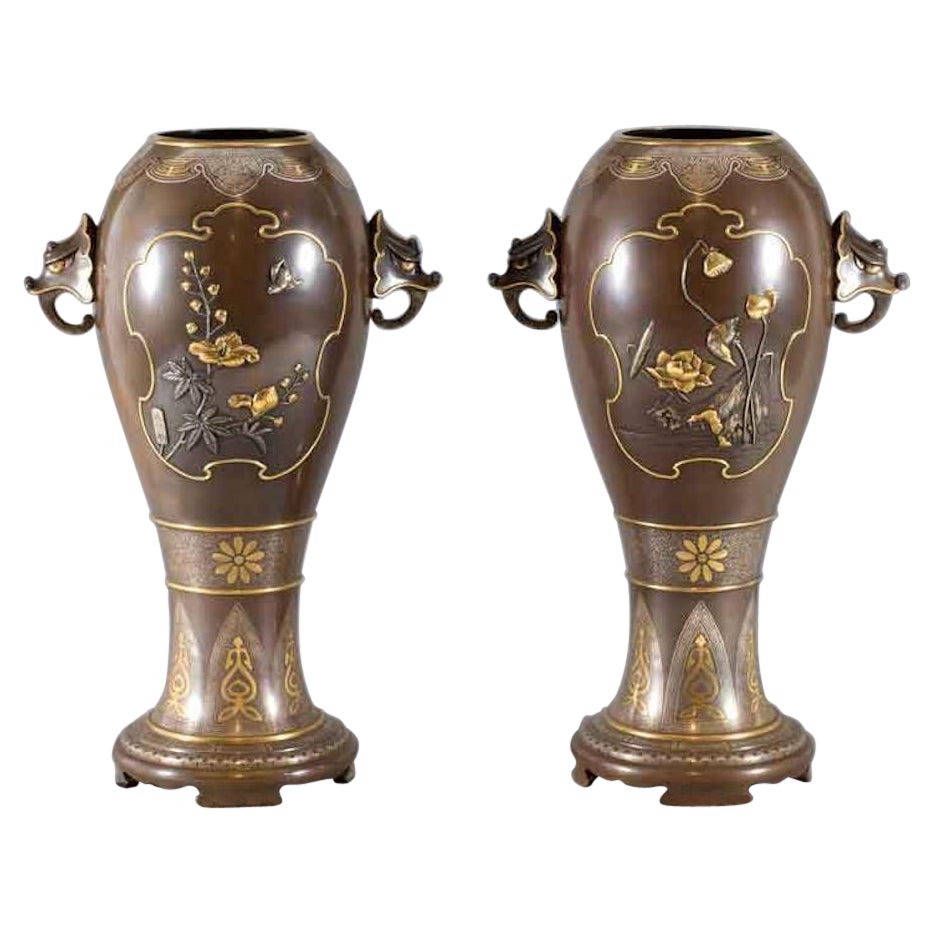Items Similar to Huge Japanese Silver and Mixed Metal Bowl by Miyamoto Shoko
Want more images or videos?
Request additional images or videos from the seller
1 of 9
Huge Japanese Silver and Mixed Metal Bowl by Miyamoto Shoko
About the Item
As part of our Japanese works of art collection we are delighted to offer this large and stylish Meiji Period 1868-1912, circa 1900 solid silver and mixed metal bowl by the renowned Miyamoto company, this significant scale vessel weighs over 172 ounces and is decorated with stylised Ho-o (Phoenix) and palownia worked in shibuichi and gold alloys, the handles are riveted to the body exposing fine quality decorative studs, the bowl contains a removable wire basket for flower display as was the intended use when manufactured and perfect as an opulent table or consul centerpiece, other functional uses could be as a large opulent wine or champagne cooler filled with ice, whatever the use this magnificent vessel would grace any space as a significant focal point , signed Miyamoto Kinsei and carrying the Jungin pure silver mark.
Literature :
The Miyamoto company was founded in 1880 originally as a promoter of cigarettes, tobacco and supplier of cigarette cases, in 1899 it moved to Tokyo where it still trades to this day, with the emergence of wealthy tourists and high ranking diplomats came the renewed appetite for gold and silver items, Miyamoto began designing and supplying vast quantities of silverware and very soon became renowned as high quality commissioning agents who’s patrons included the Imperial household and other government agency’s, the company are still favoured by the Imperial household even today.
Condition report:
Fabulous condition throughout.
Approximate sizes :
Height : 11 1/4” 28.4 cm
Width : 22 3/4″ 58 cm
Weight : In excess of 172 troy ounces (excluding mesh insert)
Free worldwide delivery and a certificate of authenticity are included within the price of this item.
- Dimensions:Height: 11.25 in (28.58 cm)Width: 22.75 in (57.79 cm)Depth: 0.1 in (2.54 mm)
- Style:Meiji (Of the Period)
- Materials and Techniques:
- Place of Origin:
- Period:
- Date of Manufacture:Circa 1900
- Condition:Wear consistent with age and use.
- Seller Location:Christchurch, GB
- Reference Number:1stDibs: LU8622236993192
About the Seller
5.0
Vetted Seller
These experienced sellers undergo a comprehensive evaluation by our team of in-house experts.
Established in 2011
1stDibs seller since 2023
Typical response time: 1 hour
- ShippingRetrieving quote...Ships From: Christchurch, United Kingdom
- Return PolicyA return for this item may be initiated within 14 days of delivery.
More From This SellerView All
- Large Japanese Silver and Mixed Metal VaseLocated in Christchurch, GBAs part of our Japanese works of art collection we are delighted to offer this large scale exceptional quality late Meiji Period 1868-1912, early Taisho period 1912-1926, pure silver...Category
Antique 19th Century Japanese Meiji Metalwork
MaterialsMetal, Silver
- Japanese Silver and Mixed Metal Koro, Artist SignedLocated in Christchurch, GBAs part of our Japanese works of art collection we are delighted to offer this super quality Meiji Period 1868-1912, pure silver and mixed metal koro or incense burner, the heavy sil...Category
Antique 19th Century Japanese Meiji Metalwork
MaterialsMetal, Silver
- Japanese Pure Silver and Mixed Metal Cranes OkimonoLocated in Christchurch, GBAs part of our Japanese works of art collection we are delighted to offer this most charming Meiji Period 1868-1912, pure silver and mixed metal sculptural okimono depicting a pair o...Category
Antique 19th Century Japanese Meiji Metalwork
MaterialsMetal, Silver
- Charming Japanese Pure Silver and Mixed Metal Table BoxBy Hattori KintaroLocated in Christchurch, GBAs part of our Japanese works of art collection we are delighted to offer this Meiji Period 1868-1912, pure silver and mixed metal table box artist signed Bunkei aside a gold seal. T...Category
Antique 1890s Japanese Meiji Metalwork
MaterialsSilver
- Large Japanese Bronze and Mixed Metal Vases By MasayukiLocated in Christchurch, GBAs part of our Japanese works of art collection we are delighted to offer this most stylish high quality pair of Meiji Period (1868-1912), bronze and mixed metal vases artist signed ...Category
Antique 19th Century Japanese Meiji Metalwork
MaterialsMetal, Bronze
- Fascinating Japanese Bronze and Mixed Metal VasesLocated in Christchurch, GBAs part of our Japanese works of art collection we are delighted to offer this most unusual pair of Meiji Period 1868-1912, bronze and mixed metal vases, each individual vase depicts...Category
Antique 19th Century Japanese Meiji Metalwork
MaterialsMetal, Silver, Bronze
You May Also Like
- Japanese Meiji Period Sterling Silver 2 Handled Basket by Katsu MiyamotoBy Miyamoto Shoko 1Located in Dallas, TXPRESENTING a GORGEOUS, VERY HIGH QUALITY and EXTREMELY RARE piece of Japanese Meiji Period Sterling Silver 2 Handled Basket by Katsu Miyamoto. EXQUISITE, EXCEPTIONAL, RARE & IMPORTANT! This is definitely a Meiji Period piece due to the fact that it is marked with the sterling silver mark “jungin”. The Meiji period was from 1868 to 1912 and in 1928 a law was introduced in Japan compelling the use of decimal marks for silver. This pre-dates that decimalization law. We are of the opinion that it is from circa 1900. Miyamoto Shoko was founded in 1880 as the first silverware specialty shop. In 1899, Miyamoto Shoko’s silverwares were ordered by the family members of the Emperor of Japan, and to this day, they are making fine and graceful handicrafts with skillful craftsmen. Loved by numerous customers since the Meiji era, Miyamoto Shoko’s products have also been given to Princess Mako and Princess Kako of Akishino, as well as Princess Aiko Toshinomiya, on their birthdays. Katsu Miyamoto (宮本勝), in 1880, in order to increase the sales of tobacco and cigarettes to foreigners founded the Moyamoto Shoko company, which produced different silverwares in general and particularly silver cigarette cases. Miyamoto’s first name, Katsu (勝) in some sources is written as “Masaru”, since 勝 kanji can be pronounced in both ways. This basket is of the HIGHEST QUALITY imaginable! The top of the basket has the MOST GORGEOUS repousse work of flowers, probably lotus flowers, with leaves and foliage. It has an underlying chevron effect chasing, reflecting parquetry. The 2 handles are cast in the form of bamboo handles. The rim of the top likewise is cast as bamboo. The base is equally stunning in a different way! It is chased with a chevron effect, like parquetry flooring and the four feet simulate pieces of sliced bamboo with an interlinking gallery of support columns, likewise, simulating bamboo. The QUALITY of WORKMANSHIP is OUTSTANDING! The pieces weighs exactly 525 grams. This piece takes my breath away! This is one for the SERIOUS COLLECTOR of EXQUISITE AND RARE Japanese silver. You will not find another like it, for sale ANYWHERE ELSE IN THE WORLD …… I know as I have searched! Provenance: Acquired from a Dallas Private Collector. Dimensions: 9.6 inches wide, 7.6 inches deep and 2.75 inches tall ( 7.25 inches tall with handles up) Condition: Very good. It looks like the base 4 legged gallery, has been repaired/re-attached to the base, but otherwise it is excellent and of Museum quality. The Meiji period (明治時代 Meiji-jidai?), also known as the Meiji era, is a Japanese era which extended from October 23, 1868 through July 30, 1912.[1] This period represents the first half of the Empire of Japan during which Japanese society moved from being an isolated feudal society to its modern form. Fundamental changes affected its social structure, internal politics, economy, military, and foreign relations. The period corresponded with the reign of Emperor Meiji after 1868, and lasted until his death in 1912. It was succeeded by the Taishō period upon the accession of Emperor Taishō to the throne. Solid silver pieces...Category
Early 20th Century Japanese Meiji Metalwork
MaterialsSterling Silver
- Japanese Silver BowlLocated in London, GBA fine Japanese silver bowl from the Meiji period of traditional double-skin, or double-wall, construction, showing especially detailed irises around...Category
Antique Early 1900s Japanese Meiji Sterling Silver
MaterialsSilver
- Antique Japanese Mixed Metals Copper & Silver Usubata Ikebana Flower VaseLocated in Philadelphia, PAA fine antique Japanese flower vase. In hand-hammered copper (or possibly a thin-bodied bronze) with applied silver bands to rim, footrim, shaped edge, and with a lotus petal border at the joint of neck and body. Having the usubata form with a wide flared neck and mouth. The 'usubata' vase is a form favored for large scale floral arrangements by the Ikenobo school, the oldest and largest school of Japanese ikebana founded in the 15th century by Buddhist monk Senno Ikenobo. It is believed that the wide and shallow rim of an usubata vase which displays the surface of the water best imitates natural conditions of growth while also contributing to the longevity of an arrangement with the increased surface area of the water better oxygenating the plants. The base retains still retains hand-hammered marks. There is evidence of seams and folds throughout from the construction, and the surface has a cloud-like brown patina throughout. Simply a wonderful Japanese mixed metal vase...Category
Antique Late 19th Century Japanese Meiji Vases
MaterialsCopper, Silver
- Japanese mixed metal dish with samurai decor, Japan Meiji eraLocated in Saverne, Grand EstMixed metal dish decorated with a samurai and two dragons among peonies on a background of stylized clouds. The chiselling is simply amazing, every subject rendered in the finest det...Category
Antique Late 19th Century Japanese Meiji Metalwork
MaterialsMetal
- Japanese mixed metal inlaid bronze vase, signed InoueLocated in Saverne, Grand EstBronze vase with inlaid decoration of birds and butterflies among cherry blossom branches, the neck and base with bamboo motif. The inlays are in hira...Category
Antique Late 19th Century Japanese Meiji Metalwork
MaterialsBronze
- Japanese Silver BowlLocated in London, GBA Meiji period Japanese silver bowl with extremely detailed iris decoration and of typical double-skin form. The bowl dates form circa 1895 and was made by Katsuzo Mune, and their ma...Category
Antique Late 19th Century Japanese Metalwork
MaterialsSilver
Recently Viewed
View AllMore Ways To Browse
Ji Co
Tibetan Coral Figurines
Safavid Brass
Cloisonne Enamel Quails
Chinese Cloisonne Enamel Ring
Bronze Asian Fisherman
Antique Tibetan Bell
Antique Tibetan Bells
Cast Iron Teapot
Japanese Iron Tetsubin
Japanese Tetsubin
Turkish Copper Ewer
19th Century Middle Eastern Arabic Coffee Pot
Abumi Japanese Stirrup
Cloisonne Fish Bowl
Khmer Bell
Tibetan Cushion Cover
Antique Menuki

